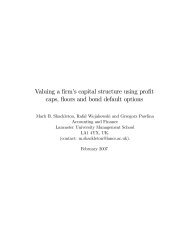Recombining Trinomial Tree for Real Option Valuation with ...
Recombining Trinomial Tree for Real Option Valuation with ...
Recombining Trinomial Tree for Real Option Valuation with ...
- No tags were found...
You also want an ePaper? Increase the reach of your titles
YUMPU automatically turns print PDFs into web optimized ePapers that Google loves.
and 1⁄ . This parameterization shows the relation of trinomial lattice and explicit finitedifference scheme (Hull 2006, 408-409, 427-428). Another common parameterization is to setp u = p d = 1/6 and p m = 2/3 (Derman et al., 1996). As a result, we can construct several kinds oftrinomial trees and apply a variety of criteria, all of which may be equally reasonable. However,despite of their limiting similarity, one kind of tree may be more convenient than another.<strong>Trinomial</strong> trees have inherently more parameters than binomial trees, so there is more freedomover the choice of the state space. Of the five parameters needed to fix the whole tree, Equations(21) and (22) provide only two constraints, so there are three more parameters than are necessaryto satisfy them. These additional parameters can be conveniently used to choose the “state space”of all node prices in the trinomial tree. As a result, it is possible to construct many “economicallyequivalent” trinomial trees which, in the limit as the time spacing becomes very small, representthe same continuous theory. These properties are often used in valuing implied trees <strong>with</strong> termandskew structure (Derman et al., 1996) as well as barrier options (Hull 2006, 573-575).4. <strong>Recombining</strong> trinomial tree <strong>with</strong> changing volatilityWhen volatilities are not constant, a common method is to choose the underlying asset prices <strong>for</strong>each node and then attempt to satisfy the two constraints through the choice of the transitionprobabilities. This method of initially choosing the state space of prices <strong>for</strong> the trinomial tree,and then solving <strong>for</strong> the transition probabilities, is familiar in most applications of the finitedifferencemethod (Derman et al., 1996). We must make a judicious choice of the state space inorder to insure that the transition probabilities remain between 0 and 1, a necessary condition <strong>for</strong>the discrete world represented by the tree to preclude arbitrage. In choosing a state space, weeliminate three of the five unknown parameters corresponding to the evolution of each node,leaving only the transition probabilities to solve <strong>for</strong>. In a trinomial tree presented in this paper,construction of the tree happens so that we simultaneously choose such a parameterization thatsets a judicious state space, i.e. specify the position of every tree node, while having sensibletransition probabilities between the nodes.As a result, there are only three restricting equations <strong>for</strong> the three transition probabilities andthree jumps, and there<strong>for</strong>e three additional equations are necessary to define a unique solution.Only one them is quite obvious to ensure that trinomial lattice is recombining: u·d = m 2 . Withoutrecombining, the number of nodes on an N-period trinomial lattice is (3 N+1 -1)*0.5 while <strong>with</strong>recombining property this reduces to (N+1) 2 , making such a lattice computationally efficient.It is convenient to divide the equation (21) by S and (22) by S 2 . Then, Equation (20) can be usedto remove p m from (21) and (22). Then, from (21) either p u or p d can be solved and substituted12



